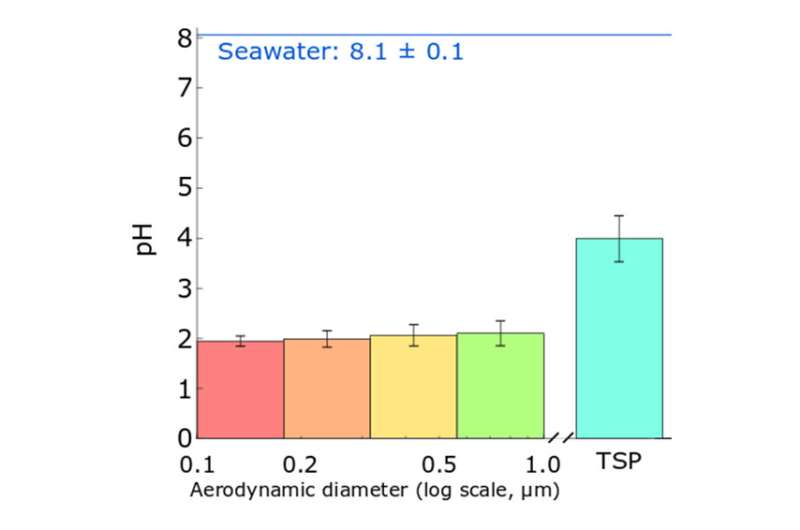Graph showing how sea spray aerosols are more acidic than seawater. “pH” is a measure acidity, with a decrease of one pH unit meaning an increase in acidity by a factor of 10. The four bars on the left show the pH of small aerosols, and “TSP” refers to “Total Suspended Particles,” which is mainly large aerosols. Credit: Angle et al., Proceedings of the National Academy of Sciences, USA, 2020
Aerosols are everywhere. These tiny liquid or solid particles populate the atmosphere, emerging from natural and artificial sources like volcanoes and oceans, and fossil fuels and agriculture. Ranging in size from less than the width of the smallest viruses to roughly the diameter of a human hair, aerosols are mighty in their impact on climate and human health.
Aerosols also can be described as warming, as in dark soot, or cooling, as in sea spray. UC San Diego Distinguished Professor of Chemistry and Biochemistry Vicki Grassian and graduate student Kyle Angle studied the cool version, showing that sea spray aerosols become more acidic within two minutes of their creation.
Sea spray aerosols are born when bubbles burst and waves crash at the ocean's surface. Before this study scientists thought that the watery particles, once produced, took their time—days or weeks—to turn "sour." But Grassian and Angle, along with a team of researchers from the Center for Aerosol Impacts on Chemistry of the Environment (CAICE), including researchers from UC San Diego, Colorado State University, University of Wisconsin-Madison and UC Davis, demonstrated that aerosol acidity also depends on size—smaller particles are more acidic than larger ones.
"The smallest particles become 100,000 times more acidic than the ocean within two minutes," said Angle, first author of the paper published online in the journal Proceedings of the National Academy of Sciences. "I expected this to happen for particles that had been interacting with pollution for days, but seeing it for fresh sea spray was an interesting finding."
The finding, according to Angle, is chemically important because the properties and reactivity of aerosols change with particle acidity. For example, the harmful pollutant sulfur dioxide is oxidized to sulfate more quickly at the interface of acidic aerosols. The sulfate can go on to act as a cloud seed in the atmosphere. The scientific community, therefore, seeks to understand these transformations in order to predict cloud formation and ultimately understand climate change.
Video of a crashing wave and sea spray in the hydraulics lab wave flume at Scripps Institution of Oceanography. Credit: Victor Or
For the broader public, these results have important implications for air quality. "More acidic particles can increase lung stress, so we must understand the causes of acidic aerosols," Angle said.
The litmus test
The basics of conducting this research, like in high school chemistry labs, involved the litmus test, used to determine if a substance is acidic or basic/alkaline.
"If you dipped litmus paper in lemon juice or vinegar, it would turn red, telling you these liquids are acidic. If you dipped it in seawater, it would turn blue, because the ocean is more alkaline," explained Angle. "When I separated sea spray aerosols based on size and applied litmus paper to them, I found that the big ones are as acidic as tomato juice and the small ones as acidic as lemon juice. This shows that the particles produced from seawater have a different pH than the original seawater."
According to Grassian, this is an unexpected finding that adds to the understanding of sea spray aerosol, an important component of the Earth's atmosphere.
More information: Kyle J. Angle et al. Acidity across the interface from the ocean surface to sea spray aerosol, Proceedings of the National Academy of Sciences (2020). DOI: 10.1073/pnas.2018397118
Journal information: Proceedings of the National Academy of Sciences
Provided by University of California - San Diego
























